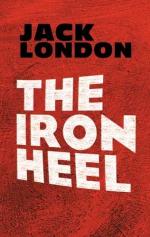“Has the Church protested?” Ernest insisted.
“The Church does not know.” The Bishop was struggling hard.
“Yet the command to the Church was, ‘Feed my lambs,’” Ernest sneered. And then, the next moment, “Pardon my sneer, Bishop. But can you wonder that we lose patience with you? When have you protested to your capitalistic congregations at the working of children in the Southern cotton mills?* Children, six and seven years of age, working every night at twelve-hour shifts? They never see the blessed sunshine. They die like flies. The dividends are paid out of their blood. And out of the dividends magnificent churches are builded in New England, wherein your kind preaches pleasant platitudes to the sleek, full-bellied recipients of those dividends.”
* Everhard might have drawn a better illustration from the Southern Church’s outspoken defence of chattel slavery prior to what is known as the “War of the Rebellion.” Several such illustrations, culled from the documents of the times, are here appended. In 1835 A.D., the General Assembly of the Presbyterian Church resolved that: “slavery is recognized in both the Old and the New Testaments, and is not condemned by the authority of God.” The Charleston Baptist Association issued the following, in an address, in 1835 A.D.: “The right of masters to dispose of the time of their slaves has been distinctly recognized by the Creator of all things, who is surely at liberty to vest the right of property over any object whomsoever He pleases.” The Rev. E. D. Simon, Doctor of Divinity and professor in the Randolph-Macon Methodist College of Virginia, wrote: “Extracts from Holy Writ unequivocally assert the right of property in slaves, together with the usual incidents to that right. The right to buy and sell is clearly stated. Upon the whole, then, whether we consult the Jewish policy instituted by God himself, or the uniform opinion and practice of mankind in all ages, or the injunctions of the New Testament and the moral law, we are brought to the conclusion that slavery is not immoral. Having established the point that the first African slaves were legally brought into bondage, the right to detain their children in bondage follows as an indispensable consequence. Thus we see that the slavery that exists in America was founded in right.”
It is not at all remarkable that this same note should have been struck by the Church a generation or so later in relation to the defence of capitalistic property. In the great museum at Asgard there is a book entitled “Essays in Application,” written by Henry van Dyke. The book was published in 1905 of the Christian Era. From what we can make out, Van Dyke must have been a churchman. The book is a good example of what Everhard would have called bourgeois thinking. Note the similarity between the utterance of the Charleston Baptist Association quoted above, and the following utterance of Van Dyke seventy years later: “The Bible teaches that God owns the world. He distributes to every man according to His own good pleasure, conformably to general laws.”
“I did not know,” the Bishop murmured faintly. His face was pale, and he seemed suffering from nausea.




